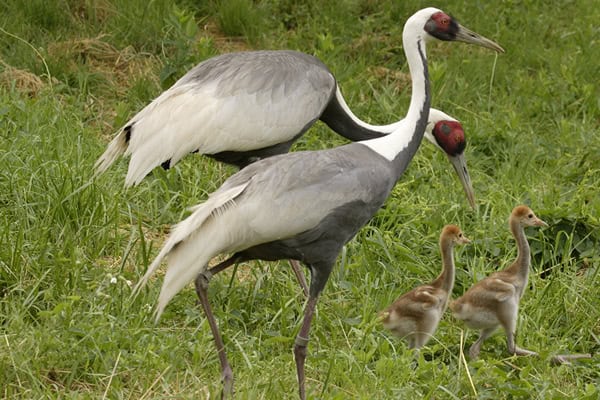Learn About the White-Naped Crane (ID Guide)
Did you know the White-Naped Crane is one of the most endangered birds, with only 6,000 left? This guide will show you why these birds are crucial to our planet’s balance. We’ll cover everything from how to spot them to their social life and the dangers they face.
By learning about the White-Naped Crane, you’ll understand why we must protect them. This guide is perfect for bird lovers or anyone interested in nature. You’ll discover lots of interesting facts about these amazing birds.
Fun Facts:
- Scientific Name: Antigone vipio
- Weight: 5 – 6 kg
- Length: 112 – 125 cm
- Wingspan: 200 – 210 cm
- Lifespan: Up to 45 years
- Diet: Omnivorous
- Habitat: Shallow wetlands, extensive river valleys, lake shores, steppes, and during migration, rice paddies and agricultural fields
- Threats: Habitat loss and illegal poaching
Physical Characteristics of the White-Naped Crane
The White-Naped Crane is known for its unique features. These make it stand out among other birds. Their physical traits show how well they adapt and live in their environment.

Plumage and Coloration
Adult White-Naped Cranes have gray feathers, which is a key feature of the species. They also have a red patch on their face and a white stripe on their neck. This look is both beautiful and unique.
Juvenile cranes look different, with brown feathers and a mottled look. This helps them hide in the wild when they are young. Their eyes and legs match their feathers, adding to their charm.
Size and Dimensions
Adult White-Naped Cranes weigh between 5 to 6 kg. They are 112 to 125 cm long, which is big for a bird like this. Their wingspan is even more impressive, reaching 200 to 210 cm. This size helps them fly well and interact with others in their habitat.
Geographic Distribution and Habitat
The White-Naped Crane lives in certain areas that meet their needs for nesting and wintering. Knowing where they live helps us understand their life cycle, how they migrate, and how to protect them.
Nesting Grounds
White-Naped Cranes nest mainly in northeastern Mongolia and northern China. They pick open marshes with shallow waters for their nests. These nests are made of grass and moss, keeping their eggs safe. Having the right habitat is key to their success in breeding.
Several important factors affect their breeding locations:
- Abundant vegetation for nesting material
- Shallow water sources for feeding and protection
- Minimal human disturbance to foster a safe environment
Wintering Areas
When winter comes, White-Naped Cranes migrate to the Korean Peninsula and the southern Japanese island of Kyūshū, especially around Izumi. Thousands gather in these warmer places. Here are key points about their wintering habits:
- They arrive from late November to early December
- They like rice paddies and estuarine wetlands
- These areas offer plenty of food and safe places to rest
Understanding the White-Naped Crane’s needs during nesting and wintering is crucial. Protecting their habitats helps ensure this beautiful species thrives in the wild.
Diet and Feeding Habits of the White-Naped Crane
The White-Naped Crane has an interesting diet that includes both plants and animals. It’s important to know what they eat to understand their role in their environment. Let’s look at the main foods they eat and how they find them.
Food Sources
In the wild, White-Naped Cranes eat:
- Insects
- Seeds
- Buds
- Roots
- Small mammals such as rats
- Frogs during chick-rearing
This diverse diet helps them survive in different seasons, especially in wetlands and farms. Their ability to eat many things shows they are omnivorous cranes. This ensures they get enough energy and nutrients.
Feeding Behavior
White-Naped Cranes use smart ways to find food. They often go to shallow wetlands or farms in groups. This helps them find food better, especially when they migrate and visit rice fields.
While foraging, they use both probing and pecking to get food from the ground. This shows how adaptable they are and how important it is to have a variety of food. Their diet and how they eat are key to their survival.
Breeding and Reproductive Behavior
The White-Naped Crane has interesting behaviors during breeding and reproduction. These birds are very loyal to each other, often staying with their partners for a long time. Their mating rituals are quite a sight, with beautiful dances and sounds. These rituals help strengthen their bond and mark their territory.
Mating Rituals
White-Naped Cranes perform special dances to show off their skills. These dances help make their relationship stronger and warn other birds to stay away. They also make sounds together, which is a way to talk to each other and claim their territory.
Nest Construction
Building a nest is a big part of their breeding process. They choose wetland areas and use plants to build their nests. The female lays two eggs, and both parents take care of them. This teamwork shows how important breeding is to them.
Chick development is very important too. After hatching, the chicks need constant attention until they can be on their own. Both parents work hard to keep their babies safe, showing how dedicated they are to their young.
Behavioral Traits and Social Structure
The White-Naped Crane shows interesting social behavior, especially in how they live together and talk to each other. Learning about these traits helps us understand their daily life and how they interact.
Group Dynamics
In the breeding season, White-Naped Cranes usually pair up. But they join bigger groups during migration and winter. These groups help protect them from predators and find food. The way they organize themselves in these groups is complex, showing both teamwork and competition.
- Breeding pairs often display strong bonds through mutual engagement.
- During migrations, cranes may form loose flocks to share resources.
- Hierarchy exists within crane groups, influencing mating rights and foraging privileges.
Communication and Duets
White-Naped Cranes use many sounds to talk to each other, with duets being a key part of their social life. Males and females make special calls together, which helps them bond and mark their territory. These rituals make their relationship stronger and let other cranes know they’re there.
- Duets can involve several distinct vocal patterns unique to the species.
- Crane vocalization varies in pitch and rhythm depending on context, such as alarm calls or mating displays.
- The ability to communicate effectively contributes to successful parenting and group cohesion.
By looking into the social behavior of White-Naped Cranes, we learn a lot about how they live together and use sounds to stay connected. This helps us see the beauty and complexity of their lives.
Conservation Status and Threats
The White-Naped Crane is listed as vulnerable and faces many threats. These include habitat destruction and poaching. With only 6,000 to 6,500 left worldwide, it urgently needs our help.
Population Trends
The crane’s numbers have been going down lately. Urban growth, farming, and climate change have hurt their homes. Keeping an eye on their numbers helps us know what to do to save them.
Conservation Efforts
Many groups are working hard to save the White-Naped Crane. They’re doing things like:
- Creating safe places for them to live and find food
- Starting breeding programs to increase their numbers
- Restoring their natural habitats
- Teaching people about the importance of their work
These efforts are key for the cranes and the ecosystems they live in. By joining in, we can help make sure this amazing crane continues to thrive.
Check Our Previous Articles:
| Mandarin Duck |
| Demoiselle Crane | A Guide |
| Black-Headed Duck: Unique Waterfowl of South America |
| Discover the Stunning Red-Breasted Goose |
| Eurasian Blue Tit: Colorful European Songbird |
Wrapping Up…
The White-Naped Crane shows how our ecosystem works in balance. It highlights the link between wildlife and their homes. By learning about this bird, we see why it’s crucial to save it.
Your help is key in watching and protecting these birds. Joining groups and local efforts helps save these amazing birds and their homes. Every little bit helps in making sure the White-Naped Crane can continue to inspire us.







